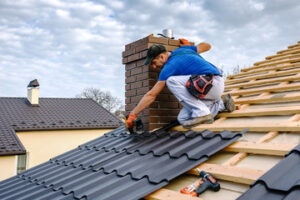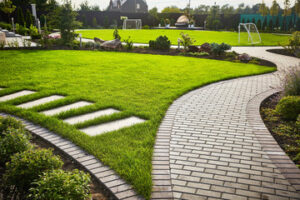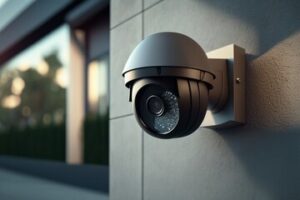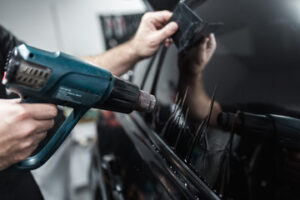Garage Door Repair Mustang OK requires a professional to ensure your safety and the proper operation of the system. However, there are many things you can check on your own to prevent costly repairs and improve the look of your home.
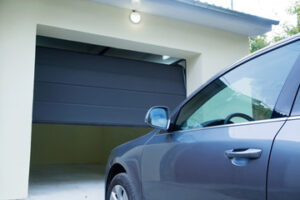
A crooked or sagging garage door often indicates broken springs. Replacing these in pairs saves money and reduces stress on the opener motor.
As they cycle through hundreds of opening and closing cycles, your garage door springs can lose their elasticity and begin to wear out. This is an inevitable part of the process, and it will eventually happen to all springs. When this occurs, the springs will no longer be able to support the weight of your garage door, and you’ll notice that it becomes difficult to open and close your garage door.
Whether you have extension or torsion springs, it’s important to call in a garage repair specialist right away when one of them breaks. Broken springs are under high tension, and they can cause serious injury if you try to handle them on your own. However, there are some temporary measures you can take if you’re willing to take the risk.
A garage door with a broken spring will often become crooked. This is because the weight of the doors is no longer evenly distributed, which can lead to loose cables and other problems down the line. If you don’t have safety cables installed, it’s a good idea to get them installed right away. These cables are designed to prevent the spring from snapping if it loses elasticity and hits something in its path.
When a torsion spring breaks, you may hear a loud bang. This is because the tightly wound coils of the spring have a lot of bound energy that can create a great deal of noise when they break. To prevent this from happening, it’s a good idea to lubricate your springs occasionally with silicone-based lubricant.
To replace a torsion spring, homeowners will first need to remove the old spring by disconnecting it from the torsion tube. Then, they’ll need to purchase a new pair of springs that are the same size as the originals. To install the new springs, homeowners will need to alternately lower and insert the winding bar into different holes on the winding cone until all of the tension is released.
Once the springs are replaced, the homeowner will need to thread a new safety cable through each end of the moveable pulley. Then, they will need to attach the ends of the cable to the track brackets. Finally, they will need to secure the new springs and make sure that they are properly centered on the torsion tube.
Damaged Panels
The panels that make up the face of your garage door are susceptible to all kinds of damage. Accidental collisions with vehicles and sports balls are among the most common causes of panel damage. But the weather is also a factor, with fluctuating temperatures and prolonged exposure to UV rays gradually leading to warping and discoloration. Finally, normal wear and tear can cause cracks and dents that may eventually lead to a loss of structural integrity.
For minor damage, a professional can often repair the affected panel with a bit of filler and some paint. However, if the damage is extensive, it might be best to consider replacing the panel altogether. Depending on the style and color of your existing garage door, it may be possible to find replacement panels that blend in perfectly.
Garage door repair technicians have a range of different tools and techniques that they can use to remove the old panels and install the new ones. They can also make any necessary adjustments to ensure that the door functions properly once the new panels are in place. This includes testing the sensors to ensure that they are able to detect obstacles in the way, and adjusting the hinges that connect the panels to the track system.
If you are considering repairing or replacing your garage door panels, it is always best to consult with an expert. They can provide advice on the most suitable solution and help you to achieve the look you want for your home. They can also provide helpful tips on how to take care of your garage door so that it lasts as long as possible.
When choosing a repair technician for your garage door, be sure to look for one with a good reputation and experience. You can ask for referrals from family and friends or do some online research to find out more about their past work. You can also read reviews from previous customers to see what their experiences have been like with the technician. This will help you to narrow down your options and choose the best repair technician for the job.
Misaligned Tracks
A garage door that has become misaligned can cause damage to the panels and other components of the system, causing costly repairs down the road. Visible gaps and misalignment can also allow drafts, pests, and other undesirables to enter your home, which is why it’s crucial that you address these issues promptly.
Often, misalignment is caused by physical damage to the tracks. This may occur as a result of an accident, such as being hit by a vehicle or object, or it could be due to natural deterioration over time. Either way, the track can bend or warp, which will affect the smooth operation of your garage door.
One of the most noticeable signs of track misalignment is a loud rubbing or scraping sound that occurs every time your garage door moves up or down. This occurs when the rollers are hitting a specific point on the tracks and can result in extensive wear and tear, which will require replacement of the track or even structural damage.
Visible gaps between your garage door and its frame are another clear indicator of track misalignment. This can allow cold air to enter during the winter and warm air in during the summer, increasing your energy bills. Additionally, it can allow drafts and other pests to enter your home, posing a risk to the health of your family and pets.
In general, the best way to avoid track misalignment is to perform regular maintenance and inspections. This will help to identify any potential problems and prevent them from arising in the first place.
When performing DIY maintenance, always work with the garage door down and never attempt to remove or loosen any screws without a suitable alternative handhold. It’s also important to use a lubricant to keep the tracks and hardware free from dirt and debris.
A good technique for straightening a bent track is to loosen the screws and bolts holding it in place and then apply leverage with a pair of pliers to gently bend it back into shape. This should be done with extreme caution, as applying too much pressure can cause the track to break.
Broken Rollers
The rollers on your garage door play a critical role in moving and functioning the system. These small, easily overlooked parts perform a lot of heavy lifting, and they’re prone to breaking down over time due to regular use, environmental elements, and a lack of proper maintenance. When they break, they can lead to a variety of problems with your garage door’s movement, safety, and overall performance. A few basic steps like lubricating them regularly and catching any signs of broken rollers can help you avoid costly replacement costs in the future.
Just like springs, rollers on a garage door come with an estimated number of cycles that they’ll be able to perform. However, because the average residential garage door experiences two to three usage cycles a day, they’ll be subject to plenty of wear and tear over time. If you’re not careful about keeping up with your rollers’ performance, they can break down prematurely and impact the lifespan of other components such as your garage door opener gears, sprockets, and belts.
When your rollers start to lose their integrity, it can cause the garage door to open and close slowly or in a visibly jerky manner. This adds stress to the entire system, potentially shortening its lifespan, and can be a major inconvenience for homeowners who depend on their garage doors daily. A professional garage door repair service can assess your rollers and replace them when necessary.
Identifying and replacing damaged or broken rollers isn’t difficult, but it’s still best left to the pros. Attempting to do this on your own can cause additional damage and result in an even more expensive replacement project. Before starting, be sure to disconnect the emergency release rope and unplug the garage door opener to prevent operation during the process. It’s also a good idea to have someone watch the situation for safety reasons.
Once you’ve removed the old rollers, bend one side of the track near the seam forward using locking pliers to remove them from the track. Be sure to remove any other remaining pieces of debris from the track and track before installing new rollers. Once installed, you can re-engage the emergency release and reconnect the garage door opener. Be sure to operate the door manually and electrically a few times to make sure that everything is working properly.

